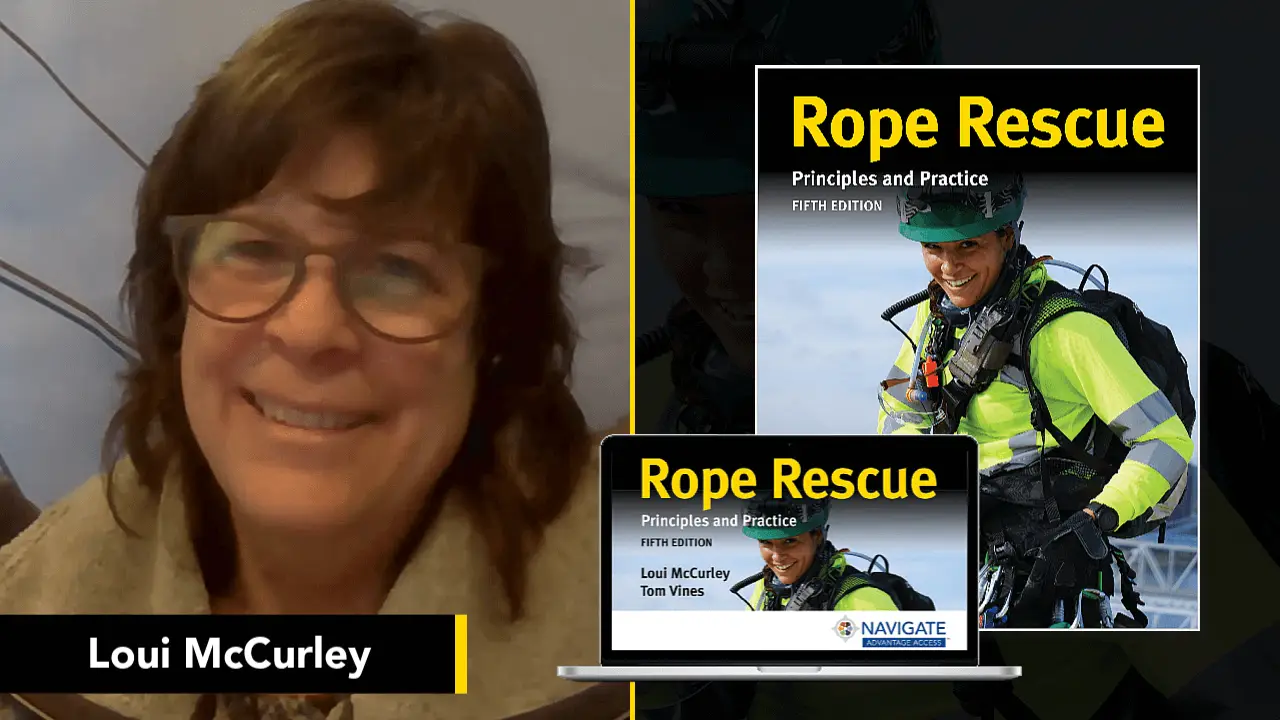Expert Says Teaching Rope Rescue Has Changed in Some Surprising Ways

Rescue technicians make up a subset of the broader Emergency Medical Services industry. Suffice it to say, not everyone is built for the danger that comes with scaling cliffs in harsh conditions to save stranded individuals.
That said, there is incredibly high value to imparting wisdom in this area as fire and rescue experts and other public safety officials can’t easily predict the scenes they’ll be called to on any given day. This is especially true in certain geographical locations.
Loui McCurley, author of Rope Rescue, Principles and Practice, Fifth Edition, is a self-proclaimed “rescue geek.” She has an extensive background in rescue, including training rescuers.
She took some time out of her busy schedule to discuss teaching rope rescue, and how the practices are evolving in some unique ways. Read on to learn her insights and be sure to watch the interview.
Technical Rescue is a Team Sport
McCurley says that over the past several years, the influence of rope access technicians, individuals who are specifically trained to do a certain job using rope equipment (such as fixing wind turbines, cleaning skyscraper windows, or scaling rocks for cleaning) has seeped into the industry. While their work is certainly impressive and necessary, actual rope rescue is not as individualistic.
“The reality is technical rescue just doesn’t have to be that complicated,” she says.
The truth is individuals are not going on rescues, teams are, she adds. Additionally, the goal is to care for people, not to be the most active, agile, or athletic.
“Adequately taking care of an injured patient through a prolonged extrication and evacuation in a back country situation is really best accomplished by a well-honed rope rescue team,” she says. “These are teams of people who work collaboratively together, with a variety of skills and techniques that they practice, so no one is working as the Lone Ranger or Superman.”
Good teams work together using litters (ie. backboards), basic knot-tying best practices, and tried-and-true systems to accomplish a rescue. And teaching teamwork will never go out of style, McCurley says.
Instructors Need to Teach Good Communication (and Social Media) Skills
Social media is ubiquitous. Instructors may not envision how social media is tied to rope and technical rescue, but, according to McCurley, social media has had a major impact on how rescues need to be performed and have increased the importance of great communication skills from rescuer to rescuer as well as from rescuer to patient.
“These days often we have communication with our subjects before we reach them,” McCurley says.
Smartphones have changed the game entirely, she says, and often for the better. But it’s important to teach potential rescuers how to communicate with individuals who may be injured, lost, or otherwise in distress as valuable seconds tick down.
“You can begin your scene size-up before you even get on scene,” she says.
She adds that one critical component to scene management is teaching a team to assign someone to be the point person just to communicate with the patient. Rescue scenes can be chaotic and overwhelming, so the simple advent of assigning a communication point person is a critical step in an effective rescue.
Adding to this, social media has impacted rescue. McCurley says she has been on scenes where the subject or the subject’s friends are filming the rescue and posting it to social media accounts in real time.
“This is a little disconcerting,” McCurley says. Rescues often attract media attention, compounding the challenges of a good rescue team. Live streaming a rescue contributes to this difficulty.
McCurley says she has found that one way to break through this is to, again, effectively engage with the subject directly and “make them a part of their own rescue.”
It comes back to simple roles and responsibilities. While McCurley says it’s important for rescuers to be aware of the challenges that come with live streaming and social media, rescuers need to stay focused on the task at hand, and leaders need to delegate responsibilities on the scene.
Rope Rescue, Like Other Techniques, is a Learned Skill
Yes, there are daredevils and adrenaline junkies who may be attracted to technical rescue due to its soaring heights and high stakes. But this drive is not necessary. In fact, in some cases, it could be a detriment.
“There’s definitely that internal drive,” McCurley says, “that said whether you have that internal drive or not, technical rescue is certainly something that can be learned or studied.”
As with anything, there are people who have more aptitude than others, but technical and rope rescue involves much more than the willingness to climb great heights.
“Just being a good climber doesn’t make us a technical rescuer,” McCurley says. “Just being a rope access technician doesn’t make us a good technical rescuer. Technical rescue is a specialized and specific skill that can and should be learned.”
Qualified instructors are invited to download a sample chapter of Rope Rescue, Principles and Practices, Fifth Edition for consideration of course adoption.
Read More:
- The Importance of Peer Support When Training First Responders
- This is Why You Should Make Community Risk Reduction a Key Part of Your Fire Service Curriculum
- How the Flipped Classroom Approach Could be a Solution to Firefighter Staffing Challenges
About the Author:
Loui McCurley is a certified Rope Access Technician and Technical Rescue Specialist, Loui has faced unique fall protection challenges in a range of unique environments ranging from wilderness to general industry, towers, turbines, agriculture, entertainment, and more. A Founder and Past President of the Society of Professional Rope Access Technicians, Loui also works with standards-setting organizations including ANSI Z359, NFPA, ASTM, ISO, FEMA/NIMS, Cordage Institute, and others.